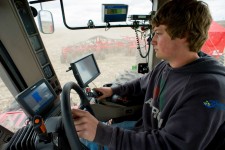South Dakota Wheat Growers: Making Connections

Precision programs can only stretch as far as their own limitations, and retail cooperative South Dakota Wheat Growers (SDWG) is creating a program that pushes those limiting factors beyond their grower-customers’ expectations.
It starts with a program that fits agronomically with a wide swath of its customers, and breaks barriers by utilizing the flexibility and connectivity of cloud computing to provide open access to managers, agronomists and grower customers.
The hopeful result will be unfettered access to information and people, and effective communication that makes the crop production process as efficient as possible.
Of course, it starts with a sound agronomic program. And according to Brent Wiesenburger, Precision Ag Manager at SDWG, the proven approach in their region is zone management. SDWG has been analyzing field needs using zone sampling since 1996. “We manage nitrogen up here, so when planting a nitrogen use crop, we pull a 0 to 6-inch and 6 to 24-inch soil test, this makes grid sampling really overwhelming on the cost side when sampling every other year. Management zones have worked really well over the years.”
Last year, the cooperative took a big step forward when it acquired MZB (short for Management Zone Based) Technologies based in Watertown SD. MZB Founder Glenn Hanson started MZB in 1996 as a way to develop and fine tune a zone management based program.
“Glenn developed a system of combining RTK elevation, both the shallow and deep layers of Veris data, and yield or satellite imagery data to establish high, medium and low yielding zones with turnkey software to make sound field management decisions,” says Wiesenburger. Satellite data is generally favored over yield data because so many growers are large and will run multiple combines, creating a serious data collection challenge at harvest time.
Based on these layers of data, as well as carry over nutrient levels analyzed by Agvise Labs, SDWG can manage phosphorus (P) based on the zone designation. “As you would expect, our low yielding zone 3 and 4 areas always have higher carryover levels of phosphorus, and our higher yielding zones tend to have lower level of carryover P. This allows us to fine tune phosphorus build strategies in ways that a grid based system can’t,” says Wiesenburger.
With a clear understanding of the zones in terms of fertility and crop performance, fertilizer recommendations can be made and yield goals established for each zone in the field using the MZB system. At SDWG, that system is called MZB Tools, a program that resides on the agronomist’s computer that allows him them to bring all the data sets together for the grower and create the field recommendation.
Next: Cloud Connectivity
Taking the MZB precision program, and in reality the entire company, to the next level of efficiency and customer interaction was going to mean pushing SDWG managers, agronomists and customers into the realm of wireless connectivity and cloud computing. To get there, they turned to AgIntegrated, a State College, PA company that has developed a cloud-based connectivity and data management program called Onsite.
“Onsite is a cloud based, multi-platform service designed to manage and communicate information between software, equipment, employees, and customers, explains Mike Santostefano, marketing director of AgIntegrated.
With retailers juggling more and more data through disconnected software and equipment, there is a need for a solution to help connect these systems and to improve the efficiency of the people who interact with them, he says.
“Onsite provides a solution to this challenge. Onsite is a cloud solution to help manage and communicate information across any software, equipment and most importantly, the individuals that use the information to make decisions and complete tasks. Instead of adding another disconnected system into the mix for retailers that increases their staff’s time commitments, Onsite’s primary goal is to compliment and connect their existing software and equipment.
With Onsite integrated into the system, the agronomist using MZB will now be able to create fertilizer and seed recommendations, then send the controller file and recommendation report to the SDWG operator and/or directly to the grower. The operator or grower can then transfer the controller file to a USB drive or compact flash card.
Mixed fleet telematics is also an important part of the program. Prescription files can be sent from any precision ag software to any brand of equipment and transfer as applied or yield data back to any precision ag software. Files can also be sent to and from equipment telematics systems such as Raven’s Slingshot, and others as well when they become available. Individuals that are not equipped with equipment telematics system can utilize wireless capabilities of Onsite Relay, which utilizes smartphones and tablets in the field.
The system will also offer a mobile app capable of tracking assets through smartphone or tablet’s GPS and allow the setting up of geofences to generate an alert when an operator crosses a boundary. It works for managers or growers — a grower can be alerted when an applicator accesses their field.
Finally, Onsite will allow file management in the cloud, so information can be disseminated efficiently, data can be stored safely and securely and agronomists can have full access to sales, marketing and customer information from anywhere.
The new, supercharged MZB program is rolling out in four locations this fall and winter, and Wiesenburger is excited about the potential. “We’ve had the software and the precision program, all we needed was the Onsite connectivity,” he says. “Everyone is waiting for this to get going.”






